
If you’re in sales and management and today’s blog post title pisses you off, I’m sorry. After all, what does a guy who’s spent his entire career on the content side know about sales?
Well, the truthful answer is, “Probably not a whole lot.” But I would turn the question back around and ask: “What do YOU know about radio sales these days?”
Or perhaps we should say media sales.
That’s because the world of marketing has been rocked by the Internet, and all the options it has spawned. It wasn’t enough that there was SEO, SEM, Google Adwords, Facebook ads, and the other tools that have been around for years. Now AI – Artificial Intelligence – is being deployed to better predict ad spending and audience targeting patterns.
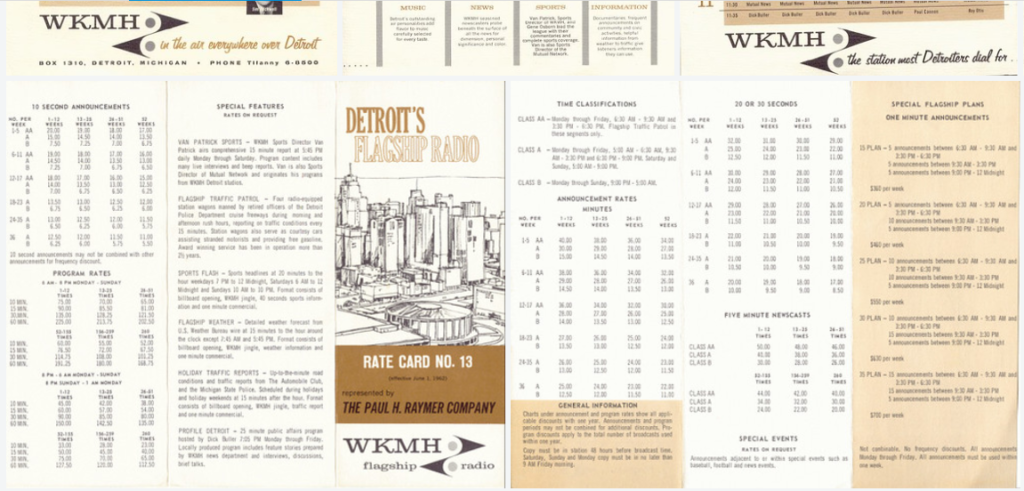
If you recognize the artifacts pictured above, you’ve been around the radio business for a long time. It’s an old rate card, the pricing device radio stations used back in the days when they could demand – and often get – their aspirational advertising rates.
If some of those rates from an AM radio station in Detroit in 1963 actually look attractive to you today, well, that says a lot about how far we’ve come. Or fallen.
I spent a night in Philadelphia this week, and I started thinking about a famous Philadelphian – John Wanamaker.
You’ve never heard of him? He was a fascinating guy, something of a Renaissance man. Back in the 1880s through the early 20th century, Wanamaker was a businessman, a political force, and even a religious leader,
And he became something of an advertising/marketing guru because of his ownership of Philly’s iconic department store – yes, Wanamaker’s. He opened his first store as the Civil War was getting started.
Wanamaker’s slogan? “One price and goods refundable.” Simple, to the point, and very marketable. But the question back in the 1860s, the advertising scene was confusing. Merchants like Wanamaker tried various ad platforms (they weren’t called platforms back then), but often were unable to determine which were effective.
And that led Wanamaker to make this statement that every advertising maven from David Ogilvy to Don Draper has uttered at one time or another:
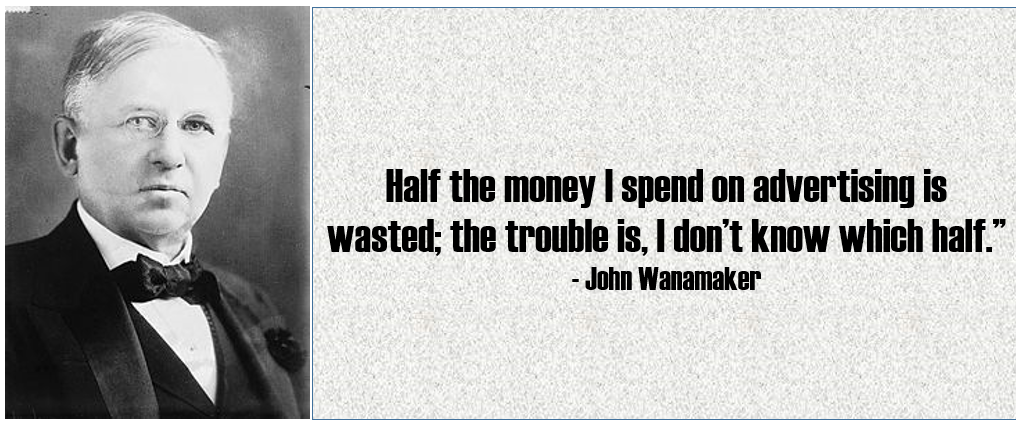
And here we are, some 120 years later, and advertisers are even more clueless and confused about the effectiveness of their marketing dollars.
This, despite so-called “accountability,” ROI, artificial intelligence, and all the other data-driven tools now available to any media buyer with a laptop.
Somehow, the debate rages. And one of the biggest advertisers in the world – Procter & Gamble – continues to test the marketing waters, trying to find the right balance between digital and traditional advertising tools.
And if P&G is struggling to answer Wanamaker’s existential question, just imagine what media buyers, local merchants, and even large agencies are experiencing.
There are no “best practices.” There is no yardstick. There are no rules. As I participate in budget meetings at both the local cluster level and with some of radio’s leading broadcasters, the sales conundrum has only intensified.
Radio exces can’t find qualified, strategic sales managers, much less salespeople. They are unable to settle on how individual stations and clusters should be sold and marketed. They continually debate the configuration of sales teams, and whether there should be dedicated digital sellers.
Many assets – podcasts, streams, websites, apps – are going unsold. Or they’re packaged as remnant advertisements where the going rates are downright embarrassing.
Many stations are facing low demands on their inventories – despite outstanding ratings. The time-honored equation: great ratings = strong demand and high rates is breaking down.
Advertisers are correspondingly roiling in confusion as a result. This came through loud and clear when staring at this chart produced by Borrell Associates this week.
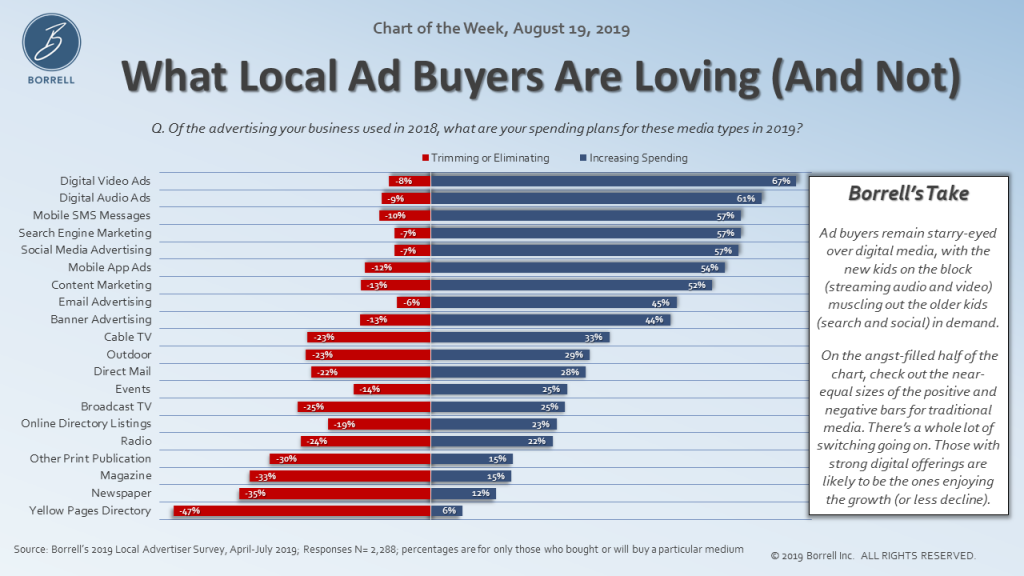
Not surprisingly, the digital tool kit is clustered near the top of this chart. Digital video ads are most in favor – to the chagrin of radio sales managers. While two-thirds of Borrell’s more than 2,000 local advertisers say they’ll increase spending in this hot sector, only 8% are in the trimming mode.
Where it gets interesting is when you look at traditional media other than print. Look at broadcast TV, direct mail, outdoor, and yes, radio. Talk about a schizophrenic advertising mindset. It seems that for every local media figure eager to advertise on radio, another is running away from AM/FM.
So, how would John Wanamaker explain this dichotomy? How can the efficacy of advertising platforms that have been around for decades and decades be a debatable issue in 2019?
Borrell’s thought is an interesting one:
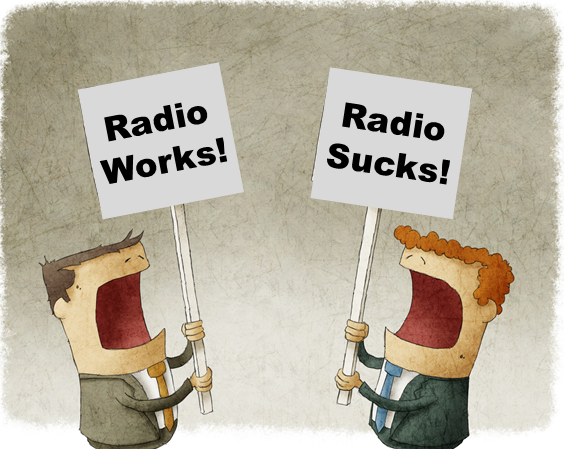 “Hands-down it’s the sales rep. High compliments go to the ones who are helping the advertisers with other forms of marketing and creative ideas.”
“Hands-down it’s the sales rep. High compliments go to the ones who are helping the advertisers with other forms of marketing and creative ideas.”
As for reps who don’t have a clue, they can be the make/break that determine whether the station (and the company that owns it) ends up with the business.
In his survey, Borrell included this open-ended question:
“What has the greatest influence on your advertising buys?”
Interestingly, more than one-third of the respondents – 800+ – commented. Gordon shared some representative comments. And as you’ll read, reps often are the difference-makers. Some even mention them by name:
“If I can know, like, and trust my salesperson, I will always buy from them. When they are pushy I wouldn’t buy from them regardless of how badly I want what they have to offer.”
“I definitely favor certain ad reps and probably buy more based on the person I am working with, but my primary concern is reaching the specific customer we are targeting.”
“A rep can make all the difference, those who get involved and learn a prospective business have everything to gain.”
“(The) sales rep certainly is part of the influence, and cost, of course.”
“I would say the sales rep/expert does influence. Also, having had a previous negative experience with the rep influences future purchases from the company. The rep was not knowledgeable about the product/service she sold. She seemed offended or surprised that I asked so many questions. I ended up paying someone else to help me understand the product/service. Then found out the company did not provide social media advertising as targeted as we wanted.”
“Sales reps come and go too fast. They are the first line in presenting it though, and do influence us. The company’s rep is big also, but the type of media is what will drive the ultimate sale. Value versus cost.”
And Borrell has the stats that strongly suggest that when a sales rep drops the ball or doesn’t represent their company well, the advertisers doesn’t drop radio. Instead, they’re more likely to give their business to another station/cluster in town.
Radio selling used to be a one-size-fits-all proposition. Buying 30s and 60s was the “secret sauce” for every advertiser – the only question was how many spots over how many weeks and their rate.
Today, savvy sellers are able to truly assess a client’s need, and architect an integrated plan that includes both traditional advertising as well as a menu of other assets – websites, apps, event marketing, podcasts, and more.
Problem is, their supply is quite a bit smaller than the outsized demand for sales reps who “get it.”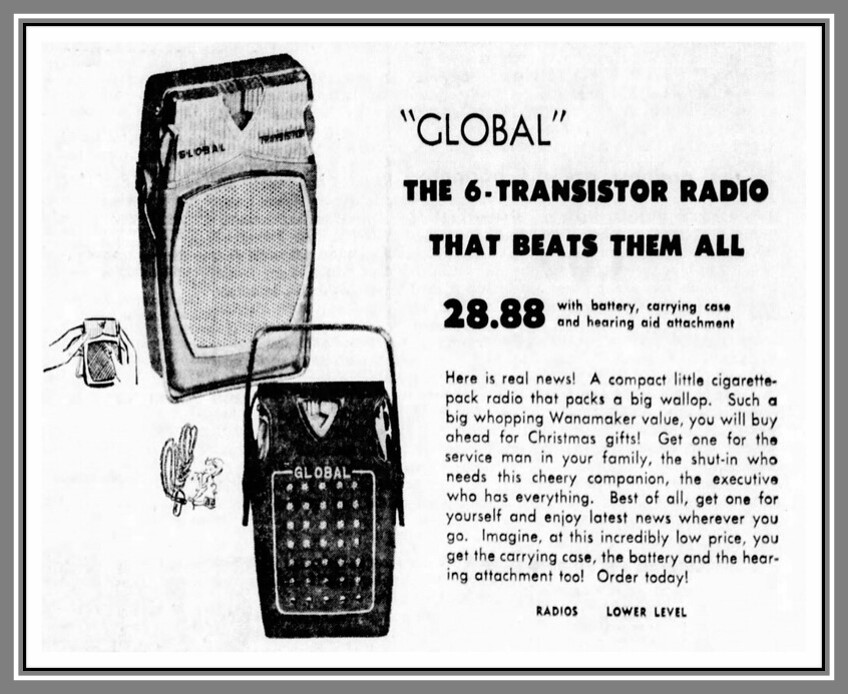
And as Borrell’s research indicates, advertisers are increasingly mixed about traditional media and its necessity in their marketing programs.
You have to wonder what John Wanamaker would make of the current conundrum.
Rumor is, he was a fan of radio.
Thanks to Keener 13 fanatic & steward, Scott Westerman, for the WKMH rate card.
- Media And Technology In 2025: Believe It Or Not! - April 18, 2025
- In Radio, You Just Never Know - April 17, 2025
- The Secret To Making A Great Podcast (And Great Radio) - April 16, 2025




When John Wanamaker had his downtown department store in Manhattan, you got off the Lexington Avenue IRT subway and there was his radio studio facing the platform. A life changing, special, early memory. Wow! That’s really cool. Subways & Radio. Sadly, some kids later said, “Wanna make a fire” and the store & studio burned and closed.
Clark, did not know that about Wanamaker’s in NYC. Thanks for sharing.
Wanamaker was the first advertiser to use radio. Actually….before radio became popular, 8 years before the first licenses were issued. He partnered with none other than Marconi. He had a remarkable instinct for marketing.
This is information I did not know, Gordon. So, what would Wanamaker made up of today’s current conundrum about marketing?
I feel a kinship to Mr. Wanamaker because of my shared Philadelphia roots (he grew up in the same neighborhood as my family in the early 1800s, and they likely knew him), and I remember Wanamaker’s in Center City and all its glory in the 1960s. So I’ve read a lot about him. He was a brilliant marketer from the start. His statement about “half works/half doesn’t” pertained only to newspapers, the only medium at the time he said it. Today’s world is much, much different, and I suspect that, had he been born 150 years later, he’d skip physical stores altogether and gone straight to the Internet. And we’d probably never know the name Jeff Bezos.
Great insights, Gordon. And continued engagement for this post – an issue that goes to the heart of the radio broadcast industry’s future as a marketing tool. Much appreciated.
Great read!!
I have been in Radio Sales for almost 34 years. I started at a very young age and I don’t mind saying it- I guess someone took a chance on me.
I started with nothing(No account list, my base was paltry at best and my gitty-up guarantee was only 90 days)- would you leave a job for a contract of that nature, perhaps not. To me, that was the best set-up they could have ever put me behind.
I knew nothing about radio sales other than I had to get going and learn on the fly as we were a desperate for business/bottom feeder network of stations with no respect in the business community. I was going to change that to the people I was going to touch.
I lived the business 24-7 and did my best to escalated my profile but most importantly:results and respect from my clients mattered the most.
My A/R is one of my tell-tales on where you are in their operation- my invoices are at the top of the payables heap and not the bottom- which is very important. I get bought and I get paid- On time!
One very important principle that I live by (Good or Bad)- be available and there when the client is ready to talk and return ALL e-mails and phone calls within an hour when possible or at least communicate you know they are looking to deal with you. A client will see your sincerity and it will pay dividends.
We are in a unique business- take advantage of it and let the client know our doors are always open for business and we can turn on a dime to get them to air ASAP- no other media can do that.
What will be your guiding light, your signature to success….i know what works for me.
Bob, we could used a few (thousand) more of you. Thanks for these great reminders. I think Gordon Borrell would agree 100% with what you’ve said. It makes a definitive difference.
Here’s what I know about selling radio advertising.
I can’t do it.
I tried and failed as a sales rep. I’m a programmer and that’s that. But I DID learn new respect for those who CAN do it!
Not a easy skill when it’s done well, Zeb. Question is, how do we find & train those who can?
I continue to see radio/media sales from the other side of the table for the first time in my career.
People would do WELL to take your thoughts (and Gordon’s) to heart.
Appreciate that thumbs-up, Dave.
I have always believed that Radio, like all mediums, sells itself WHEN a salesperson presents an idea rather than a space. Let me explain: If you walk into a shoe store, do you browse the boxes, buy one and then see what’s inside? No, that sales model will not work, but it is exactly what many in advertising do every day… ask people to buy boxes.
A trained rep… even a three-week-on-the-street-neophyte can make sales in radio or web or even newspaper if they understand a few things BEFORE presenting. What does the business they are going in to sell? What is the avatar of their target customer? What is their competitive advantage (and no PRICE is rarely the advantage). Who are they comnpeting with? (If they sell anything that is on Amazon.com or Walmart.com, better revisit that competitive advantage statement). What do their competitors offer that this business cannot or won’t?
THEN the magic starts. The IDEAS that will help this business reach that avatar and help cause a change in their behavior… the ad idea or copy. People coming up in the business now have resources I never could have imagined when I picked up my first rate card in the ’70s. They have GOOGLE! They can find trends, tax revenue categories, BLS stats, Census stats, corporate information on the lines these people sell and the trends. It’s all there if you look for it.
Years back I found out that nearly every radio station has some kind of training. I also found out that the training was mostly theory. I put up a free site to help new sales people get started. I found that people who went through this 15 day plan would start making sales quickly (like in the third week), or find out that radio advertising sales was not for them. To this end, some radio companies I know ask a candidates to go through this schooling just to see if after three weeks they even WANTED the job.
To the point: If you learn how to formulate ideas that connect a business with the avatar-similar portion of whatever audience you have, you can sell that medium. AND, once you have this skill, if you take the time to learn about all competing media, you become a trusted advisor who can help with every part of their marketing plan. Do they want a Facebook ad? You already know that the perfect size is 1200px X 628px. You know that paying for “boosting” on Facebook makes about as much sense as buying Insurance on a Black Jack table. Do they want to try google ads? YOU know how much their prescribed keywords cost, the average number of clicks in that category to get a lead and THEIR closing ration so as to show an ROI per Dollar spent on Google Ad Words (in many cases it is the highest CPM out there).
Fred, keep fighting the good fight. You state it all very well and always have. Oh and if anyone wants to see the FREE (and I do mean free… there are no upsells or anything in this), go to RadioSaleasSchool.com
Chris, I appreciate the kind words. And more importantly, the logical but elusive picture you paint. I’d bet managers and owners are contemplating how many millions (billions?) they’ve spent on sales training over the years, only to be stuck at “GO!” in 2019. Selling and marketing radio ads have always been harder than it looked. As I am fond of saying, for most sales department, the only thing worse than lousy ratings is great ratings.
Sales is not answering the phone, quoting rates, and booking the time. It is solving a client’s problems, and now the arsenal for doing just that has expanded. But sales reps need to know the weapons and they need to bring to the fight. And because integration has become of critical importance, the challenge is strategizing and packaging a station’s assets for optimal results.
It is NOT standing around the PDs office, wondering if programming can come up with a promotion so she can get the buy. Or begging to create another benchmark feature in afternoon drive to off-load yet another lame sponsorship.
Like you, I am saddened by the current state of affairs because repeated failure to achieve goals is now coming at the expense of the product. And given the competition we have for the consumer’s time and attention, now is NOT the time to be slashing away at the content side.
Your offer is appreciated, and if any of our readers take you up on it, I hope we hear about the results. Thanks, Chris.
I use that quote all the time but I use it to point out that Mr. Wanamaker is incorrect.
The truth is that over 99% of your advertising dollar can be wasted depending on the medium you use.
The people who sell direct mail will tell you that a 1% response rate is fantastic. What do we call the other 99%? I call it “Junk Mail”.
The “advertising gurus” who love buzzwords and new shiny objects will tout how their click through rates of .34% are double the national average. Is the remaining 99.66% even seen by human eyes?
Don’t get me wrong. Even that small percentage can make a profitable campaign.
But if you want 100% of your advertising to make an impression, create good copy and repeat in on a broadcast medium, say RADIO for example, where it’s intrusiveness will impact people even if they are not actively or conscientiously listening.
Those people may not be in the market today, but if we can put a piece of your ad in their head that they remember when they come into the market, then that dollar is not wasted like in other mediums you may use.
In fact, that familiarity will increase the effectiveness of your digital, direct mail, or any other advertising you do.
I know I am not a huge fan of Taylor Swift’s music but I know the words to many of her songs through the sheer repetition and the catchiness of the delivery. It’s also why I hear children singing along with the jingles I have encouraged clients to invest in.
It is funny how technology changes but human nature and the way we are impacted by music and speech doesn’t.
The problem we have had in the radio industry is that we have reps that don’t tell advertisers the dirty little secret and that is every radio station in the any market has enough listeners to give that advertiser a bang for their buck if they have good creative and enough repetition.
Many reps don’t give the client either and when they let them run spots that talk about family owned” being a benefit (I know most people shop at Wal-Mart because the Walton family owns it) and then sell them a plane ticket halfway to Europe, the clients will come back and blame every sales rep in the medium.
Of course there are also the reps that still tout themselves being “Number 1” and why would they be on anyone else when the real goal should be to make the client “Number 1” with our audience.
We tell our “story” in Radio but unfortunately it is a story around us rather than a story about what our client truly want – to make money.
A good rep knows how to use the medium to do that.
And something tells me, Mike, that at one time, you were a good rep. Probably a great rep. As you point out, the essence of marketing is getting inside consumers’ heads. Radio provides an almost subliminal way of doing that. I’m sorry, but I make every effort to change radio stations (terrestrial or satellite) every time that Kars For Kids spot comes on. And yet, somehow, I know the damn song/jingle (and the phone number) by heart, and probably will until my last day on earth.
One of the really amazing things about this audio resurgence we’re experiencing, whether it’s technical (air pods, soundbars) or content (podcasts, audio signatures) is that we’re watching marketers now try to get their heads around how it all works. Radio people – assuming they’ve been paying attention – inherently know this stuff. But without rankers, ratings, and rate cards, they often have nothing to talk about.
It’s a sad state of affairs. We could use more sales training – not how to read the Nielsen numbers, but how to conceptually market the beauty of our product and how it goes so well with the new media in our lives. Thanks for the inspirational comment.
Great article! I have been in entertainment/media/sales my entire career and i can say that proving media attribution is close to impossible but a great Salesperson will make their best effort to try and be honest with the client, that’s what builds a successful relationship.
Sales funnels, paths to purchase and last click attributions are all conversations that need to be had. My two favorite saying I have learned are “Have the customer know you before they need you” and “A Sales Rep without data is just another person with an opinion” (from a Borrell presentation).
Good stuff, Cliff. Thanks for sharing & for the kind words.
I can honestly say #RadioWorks in the Cayman Islands. On an island that is 24 x 7 miles, we have 16 radio stations. I LOVE selling 4 of them and achieving measurable results for my clients. Radio, Social Media and Digital advancements work beautifully together to drive results for my customers. The key is to listen to your clients and the radio of course!
Think of us as you’re strolling the “Seven Mile Beach.” What a wonderful place to live….and obviously, sell radio.